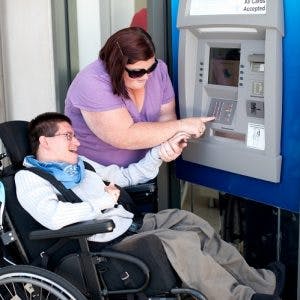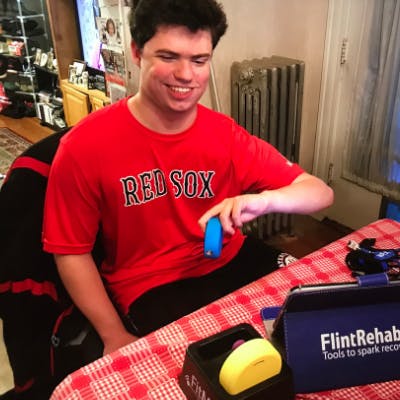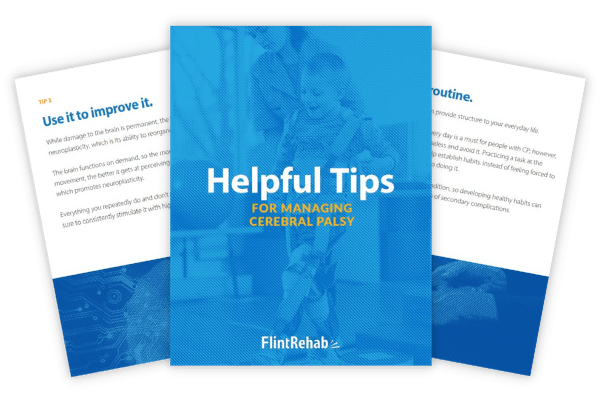Cerebral palsy is a motor disability that affects movement in the body. Sometimes it can affect the whole body, but with spastic hemiplegia, only the left or right half of the body is affected. When an individual with spastic hemiplegia struggles with movement on the left or right side of the body, it can cause difficulty with balance, gait, and participation in daily activities. Fortunately, there are many available methods for rehabilitation.
To help you understand what spastic hemiplegia is, this article will discuss:
- What causes spastic hemiplegia?
- What are the effects of spastic hemiplegic cerebral palsy?
- How to manage spastic hemiplegia
Causes of Spastic Hemiplegia
When cerebral palsy affects only one side of the body, it is called spastic hemiplegia. To understand this condition, it helps to have a basic understanding of how the brain controls movement.
The brain consists of 2 hemispheres. The right hemisphere controls movement on the left side of the body, and the left hemisphere controls movement on the right. Therefore, when an individual with spastic hemiplegia struggles with movement on one side of the body, it stems from damage on the opposite side of the brain.
More specifically, spastic hemiplegia is caused by damage to the motor cortex. This region of the brain is primarily responsible for the execution of voluntary movements.
While spastic hemiplegia is one of the most common types of cerebral palsy, everyone experiences it differently. Individuals may experience a wide range of secondary effects at varying severities, depending on the extent of the damage to the brain.
One common characteristic among individuals with this type of cerebral palsy is that they often experience more severe motor impairments in the affected upper limbs than the affected lower limbs. In the following section, we’ll discuss other common effects of spastic hemiplegia.
Effects of Spastic Hemiplegic Cerebral Palsy

Spastic cerebral palsy is primarily characterized by high muscle tone (spasticity). Because the transmission of messages between the brain and muscles is damaged, spasticity occurs and the muscles remain involuntarily contracted.
When only one side of the body experiences spasticity, it can harm a child’s growth due to excess strain on the joints and muscles. In comparison to the nonaffected side, the affected side may not be able to grow or function optimally.
Spasticity can restrict range of motion and discourage children from using their affected side. For example, if a toy is on the child’s left side, they may turn their entire body to grab the toy with their right hand rather than pick it up with their left hand.
When the affected side of the body is “neglected” and unused during daily activities, children may develop developmental disregard. While it is completely normal to have a dominant side, becoming overly dependent on one side of the body can result in poor bilateral coordination (the ability to use both hands at the same time) and make everyday tasks much more difficult to perform. Additionally, the affected side of the body may lose functional skills and abilities, which makes it more difficult to use in the future.
Other common effects of spastic hemiplegic cerebral palsy include:
- Stiff movements
- Abnormal gait (walking pattern)
- Asymmetric growth
- Distortions
- Unstable trunk control (leaning to one side)
- Poor fine motor skills in the affected hand
Because every individual experiences spastic hemiplegia differently, it’s essential to seek personalized care. In the following section, we’ll discuss interventions that may help effectively manage spastic hemiplegia.
How to Manage Spastic Hemiplegia

Spasticity can be referred to as a “reversible type of muscle stiffness” because it often can be temporarily reduced through the use of medications, therapies, and surgeries. However, to permanently reduce spasticity, individuals must stimulate the brain’s ability to reorganize itself (neuroplasticity).
The brain is extremely adaptive, and every action we perform stimulates it. The more you practice a function, the better the brain gets at perceiving a demand for it, which encourages it to rewire its neural circuitry. As a result, motor functions affected by spasticity may be rewired to healthy areas of the brain. By practicing highly repetitive and task-specific movements with their affected side, individuals with spastic hemiplegia can help promote permanent improvements.
Below, we’ll discuss some management interventions that can help individuals manage spastic hemiplegia.
Physical Therapy
The goal of physical therapy is to help improve a client’s motor control through targeted exercises. A physical therapist will assess the severity of an individual’s motor impairments and develop a customized exercise regimen to:
- stretch tight muscles
- strengthen underused muscles
- maintain or expand range of motion
- encourage appropriate postures and positioning
- practice new movement patterns
Physical therapists help guide clients through exercises and make sure that they’re targeting the correct muscles. They may also recommend assistive devices, such as a walker or crutches, to assist with movement.
Constraint-Induced Movement Therapy
To avoid developmental disregard, individuals with spastic hemiplegia must continuously practice using their affected side properly. Constraint-induced movement therapy focuses on promoting the use of the affected arm by discouraging use of the non-affected arm.
Typically, the therapist instructs the individual to wear a glove or mitt on their unaffected hand to discourage its use. Then, the affected arm undergoes intensive training. Therapists often encourage individuals to continue using the glove or mitt at home while in the period of intensive training to further promote use of the affected arm. The goal is to promote neuroplasticity through repetitive stimulation.
Although it has not been studied specifically in individuals with cerebral palsy, therapists may also utilize constraint-induced movement therapy in a similar fashion to focus on increasing use of the affected leg.
Occupational Therapy
Occupational therapy can help individuals with spastic hemiplegia become more independent by practicing activities of daily living such as using silverware, writing, dressing and brushing their teeth. Additionally, individuals may practice fine motor activities and using both sides of their body to develop bilateral coordination skills and perform tasks more efficiently.
Occupational therapists are also able to recommend adaptive equipment to increase independence and safety with activities of daily living, such as using built-up handles for utensils or installing grab bars in the shower. They may also encourage use of compensatory strategies, such as dressing the affected side first and undressing it last, to increase overall independence.
Medications
Medications like baclofen and Botox can help temporarily reduce spasticity by inhibiting signals that cause muscles to contract.
However, these medications won’t permanently reduce spasticity. Instead, individuals should take advantage of their reduced muscle tone and practice moving and using their affected side as much as possible to promote adaptive changes in the brain. Improvements made while using Botox or baclofen can carry over even once the medication wears off.
Orthotics
Orthotics like braces, casts, and splints help support proper musculoskeletal alignment.
Because the brain damage that causes cerebral palsy occurs in early childhood, spastic hemiplegia can significantly affect the way a child’s body develops. Wearing orthotics can help provide trunk support, stabilize the limbs in place, and provide prolonged gentle stretching of spastic muscles.
Surgery
Generally, surgery is only recommended when all other forms of spasticity management prove ineffective.
Surgery for spastic hemiplegia generally involves manually lengthening and realigning the muscles or selectively cutting the nerve roots for a specific muscle to reduce its excitability.
Spastic Hemiplegia: Key Points
When an individual with cerebral palsy experiences motor impairments on one side of the body, it is referred to as spastic hemiplegia. Motor impairments are caused by damage to the opposite hemisphere of the brain. Therefore, damage to the left hemisphere causes motor impairments on the right side of the body and vice versa.
Fortunately, the brain is capable of making neuroadaptive changes through highly repetitive, task-specific stimulation. By managing spasticity and consistently training the affected side of the body, individuals with spastic hemiplegia can stimulate neural adaptations in the brain and improve motor control on their affected side.
We hope this article helped you gain a better understanding of what spastic hemiplegia is and how to manage it.














